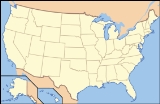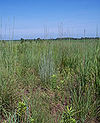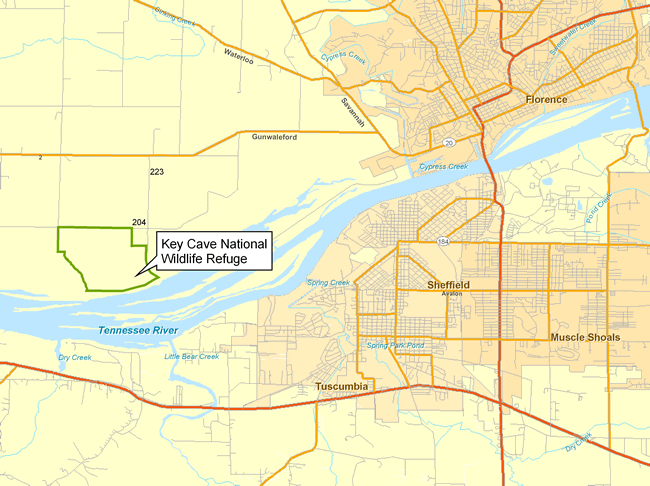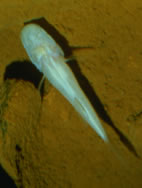
Key Cave National Wildlife Refuge
Encyclopedia
Key Cave National Wildlife Refuge is a 1,060 acre (4.3 km2) National Wildlife Refuge
located in northwestern Alabama
, along the Tennessee River
downstream from Florence, Alabama
. Additional purchases are under negotiation which will increase the size of the refuge to 1,800 acres (7.3 km2).
More than 6,000 visitors per year visit the refuge. The facility is unstaffed, but is administered by the Wheeler National Wildlife Refuge
in Decatur, Alabama
.
 Two caves, Key Cave and Collier Cave, lie within the refuge, approximately 1.5 miles (2.4 km) apart. Both caves are closed to the public. Each is on the northern shore of Pickwick Lake
Two caves, Key Cave and Collier Cave, lie within the refuge, approximately 1.5 miles (2.4 km) apart. Both caves are closed to the public. Each is on the northern shore of Pickwick Lake
on the Tennessee River
. The area also contains several sinkhole
s and underground cave systems, including a 38 acres (153,780.7 m²) sinkhole lake. The sinkholes and cave systems provide a source of groundwater
for the caves. The refuge is set up to minimize the pollution of this groundwater.
The land suffers from severe erosion
due to the extensive farming in the area. A restoration of the land to native warm season grasses and mixed hardwoods is underway in order to protect the cave groundwater area. Approximately 338 acres (1.4 km2) of the land is used for corn and soybean production under a Cooperative Farm Agreement. Fields of warm season grasses such as Big Bluestem (Andropogon gerardii), Little Bluestem (Schizachyrium scoparium), Indiangrass (Sorghastrum nutans
), Sideoats Grama (Bouteloua curtipendula), Switchgrass (Panicum virgatum), and Eastern Gamagrass (Tripsacum dactyloides
) cover 260 acres (1.1 km2) of land. 122 acre (0.49371692 km²) of hardwood forest has been planted to help control the erosion. There are an additional 30 acres (121,405.8 m²) of erosion drainages which are being converted to grassland or hedge
row habitat, 16 acres (64,749.8 m²) being used as shallow water areas, and 256 acres (1 km²) of hardwood forests consisting primarily of oak
and hickory
trees.
 The land of the Key Cave NWR area has historically been used for agricultural purposes, primarily in farming cotton
The land of the Key Cave NWR area has historically been used for agricultural purposes, primarily in farming cotton
. The area receives its name from William Key, who owned the land the refuge now contains as well as a plantation house on nearby private property. A slave cemetery called "Key Cemetery" is located on the refuge.
In 1990, the Ozark Underground Laboratory tested the underground water table
and determined that the area suffered from chemical pollution
from nearby cotton, soybean, corn, and wheat farming operations. The Key Cave and Collier Cave share the same aquifer
system which was being polluted as a result of the farming operations.
In 1992, the Monsanto Company sold the land in the highest hazard risk area to The Conservation Fund
. This land was later sold to the U.S. Fish and Wildlife Service which established the Key Cave NWR on January 3, 1997.
 Key Cave is a critical habitat for the endangered Alabama cavefish
Key Cave is a critical habitat for the endangered Alabama cavefish
(Speoplatyrhinus poulsoni). Only nine specimens are known to exist. The refuge also provides protection for approximately 40,000 endangered Gray Bat
s (Myotis grisescens). The cave is also home to two species of endangered crayfish
: Phantom cave crayfish
(Procambarus pecki) and Cambarus jonesi.
Key Cave NWR also manages several bird species including Grasshopper Sparrow
s (Ammodramus savannarum), Dickcissel
s (Spiza americana), Northern Harriers
(Circus cyaneus), Short-eared Owl
s (Asio flammeus), Loggerhead Shrike
s (Lanius ludovicianus), and Northern Bobwhites (Colinus virginianus).
National Wildlife Refuge
National Wildlife Refuge is a designation for certain protected areas of the United States managed by the United States Fish and Wildlife Service. The National Wildlife Refuge System is the world's premiere system of public lands and waters set aside to conserve America's fish, wildlife and plants...
located in northwestern Alabama
Alabama
Alabama is a state located in the southeastern region of the United States. It is bordered by Tennessee to the north, Georgia to the east, Florida and the Gulf of Mexico to the south, and Mississippi to the west. Alabama ranks 30th in total land area and ranks second in the size of its inland...
, along the Tennessee River
Tennessee River
The Tennessee River is the largest tributary of the Ohio River. It is approximately 652 miles long and is located in the southeastern United States in the Tennessee Valley. The river was once popularly known as the Cherokee River, among other names...
downstream from Florence, Alabama
Florence, Alabama
Florence is the county seat of Lauderdale County, Alabama, United States, in the northwestern corner of the state.According to the 2005 Census Bureau estimates, the city's population was 36,721....
. Additional purchases are under negotiation which will increase the size of the refuge to 1,800 acres (7.3 km2).
More than 6,000 visitors per year visit the refuge. The facility is unstaffed, but is administered by the Wheeler National Wildlife Refuge
Wheeler National Wildlife Refuge
The Wheeler National Wildlife Refuge is a 35,000 acre National Wildlife Refuge located along the Tennessee River near Decatur, Alabama...
in Decatur, Alabama
Decatur, Alabama
Decatur is a city in Limestone and Morgan Counties in the U.S. state of Alabama. The city, affectionately known as "The River City", is located in Northern Alabama on the banks of Wheeler Lake, along the Tennessee River. It is the largest city and county seat of Morgan County...
.
Topography

Pickwick Lake
Pickwick Lake is the reservoir created by Pickwick Landing Dam as part of the Tennessee Valley Authority. The lake stretches from Pickwick Landing Dam to Wilson Dam....
on the Tennessee River
Tennessee River
The Tennessee River is the largest tributary of the Ohio River. It is approximately 652 miles long and is located in the southeastern United States in the Tennessee Valley. The river was once popularly known as the Cherokee River, among other names...
. The area also contains several sinkhole
Sinkhole
A sinkhole, also known as a sink, shake hole, swallow hole, swallet, doline or cenote, is a natural depression or hole in the Earth's surface caused by karst processes — the chemical dissolution of carbonate rocks or suffosion processes for example in sandstone...
s and underground cave systems, including a 38 acres (153,780.7 m²) sinkhole lake. The sinkholes and cave systems provide a source of groundwater
Groundwater
Groundwater is water located beneath the ground surface in soil pore spaces and in the fractures of rock formations. A unit of rock or an unconsolidated deposit is called an aquifer when it can yield a usable quantity of water. The depth at which soil pore spaces or fractures and voids in rock...
for the caves. The refuge is set up to minimize the pollution of this groundwater.
The land suffers from severe erosion
Erosion
Erosion is when materials are removed from the surface and changed into something else. It only works by hydraulic actions and transport of solids in the natural environment, and leads to the deposition of these materials elsewhere...
due to the extensive farming in the area. A restoration of the land to native warm season grasses and mixed hardwoods is underway in order to protect the cave groundwater area. Approximately 338 acres (1.4 km2) of the land is used for corn and soybean production under a Cooperative Farm Agreement. Fields of warm season grasses such as Big Bluestem (Andropogon gerardii), Little Bluestem (Schizachyrium scoparium), Indiangrass (Sorghastrum nutans
Sorghastrum nutans
Sorghastrum nutans, commonly known as Yellow Indiangrass, is a North American prairie grass found in the central and eastern United States and Canada, especially in the Great Plains...
), Sideoats Grama (Bouteloua curtipendula), Switchgrass (Panicum virgatum), and Eastern Gamagrass (Tripsacum dactyloides
Tripsacum dactyloides
Tripsacum dactyloides is a prairie grass of the Great Plains. Gama Grass is found as far northwest as Nebraska....
) cover 260 acres (1.1 km2) of land. 122 acre (0.49371692 km²) of hardwood forest has been planted to help control the erosion. There are an additional 30 acres (121,405.8 m²) of erosion drainages which are being converted to grassland or hedge
Hedge
Hedge may refer to:* Hedge or hedgerow, line of closely spaced shrubs planted to act as a barrier* Hedge , investment made to limit loss* Hedge , intentionally non-committal or ambiguous sentence fragments-See also:...
row habitat, 16 acres (64,749.8 m²) being used as shallow water areas, and 256 acres (1 km²) of hardwood forests consisting primarily of oak
Oak
An oak is a tree or shrub in the genus Quercus , of which about 600 species exist. "Oak" may also appear in the names of species in related genera, notably Lithocarpus...
and hickory
Hickory
Trees in the genus Carya are commonly known as hickory, derived from the Powhatan language of Virginia. The genus includes 17–19 species of deciduous trees with pinnately compound leaves and big nuts...
trees.
History

Cotton
Cotton is a soft, fluffy staple fiber that grows in a boll, or protective capsule, around the seeds of cotton plants of the genus Gossypium. The fiber is almost pure cellulose. The botanical purpose of cotton fiber is to aid in seed dispersal....
. The area receives its name from William Key, who owned the land the refuge now contains as well as a plantation house on nearby private property. A slave cemetery called "Key Cemetery" is located on the refuge.
In 1990, the Ozark Underground Laboratory tested the underground water table
Water table
The water table is the level at which the submarine pressure is far from atmospheric pressure. It may be conveniently visualized as the 'surface' of the subsurface materials that are saturated with groundwater in a given vicinity. However, saturated conditions may extend above the water table as...
and determined that the area suffered from chemical pollution
Surface runoff
Surface runoff is the water flow that occurs when soil is infiltrated to full capacity and excess water from rain, meltwater, or other sources flows over the land. This is a major component of the water cycle. Runoff that occurs on surfaces before reaching a channel is also called a nonpoint source...
from nearby cotton, soybean, corn, and wheat farming operations. The Key Cave and Collier Cave share the same aquifer
Aquifer
An aquifer is a wet underground layer of water-bearing permeable rock or unconsolidated materials from which groundwater can be usefully extracted using a water well. The study of water flow in aquifers and the characterization of aquifers is called hydrogeology...
system which was being polluted as a result of the farming operations.
In 1992, the Monsanto Company sold the land in the highest hazard risk area to The Conservation Fund
The Conservation Fund
The Conservation Fund is an American environmental non-profit with a dual charter to pursue both economic development and environmental preservation.The Fund partners with community, government and corporate leaders to fulfill their conservation priorities...
. This land was later sold to the U.S. Fish and Wildlife Service which established the Key Cave NWR on January 3, 1997.
Wildlife

Alabama cavefish
The Alabama cavefish, Speoplatyrhinus poulsoni, is a critically endangered type of cavefish which lives in underground pools in Key Cave, located in northwestern Alabama, United States in the Key Cave National Wildlife Refuge...
(Speoplatyrhinus poulsoni). Only nine specimens are known to exist. The refuge also provides protection for approximately 40,000 endangered Gray Bat
Gray Bat
Myotis grisescens once flourished in caves all over the southeastern United States, but due to human disturbance, Gray Bat populations declined severely during the early and mid portion of the 20th century. At one cave alone, the Georgetown Cave in Northwestern Alabama, populations declined from...
s (Myotis grisescens). The cave is also home to two species of endangered crayfish
Crayfish
Crayfish, crawfish, or crawdads – members of the superfamilies Astacoidea and Parastacoidea – are freshwater crustaceans resembling small lobsters, to which they are related...
: Phantom cave crayfish
Phantom cave crayfish
Cambarus pecki , sometimes called the phantom cave crayfish, is a species of crayfish in the family Cambaridae. It is endemic to Alabama where it is found in three unconnected caves in the Tennessee River drainage in Colbert County, Lauderdale County, and Morgan County....
(Procambarus pecki) and Cambarus jonesi.
Key Cave NWR also manages several bird species including Grasshopper Sparrow
Grasshopper Sparrow
The Grasshopper Sparrow, Ammodramus savannarum, is a small sparrow. The Ammodramus genus of 11 species inhabit grasslands and marshes....
s (Ammodramus savannarum), Dickcissel
Dickcissel
The Dickcissel is a small American seed-eating bird in the family Cardinalidae. It is the only member of the genus Spiza, though some sources list another supposedly extinct species...
s (Spiza americana), Northern Harriers
Hen Harrier
The Hen Harrier or Northern Harrier is a bird of prey. It breeds throughout the northern parts of the northern hemisphere in Canada and the northernmost USA, and in northern Eurasia. This species is polytypic, with two subspecies. Marsh Hawk is a historical name for the American form.It migrates...
(Circus cyaneus), Short-eared Owl
Short-eared Owl
The Short-eared Owl is a species of typical owl . In Scotland this species of owl is often referred to as a cataface, grass owl or short-horned hootlet. Owls belonging to genus Asio are known as the eared owls, as they have tufts of feathers resembling mammalian ears. These "ear" tufts may or may...
s (Asio flammeus), Loggerhead Shrike
Loggerhead Shrike
The Loggerhead Shrike is a passerine bird. It is the only member of the shrike family endemic to North America; the related Northern Shrike occurs north of its range but also in the Palearctic....
s (Lanius ludovicianus), and Northern Bobwhites (Colinus virginianus).

